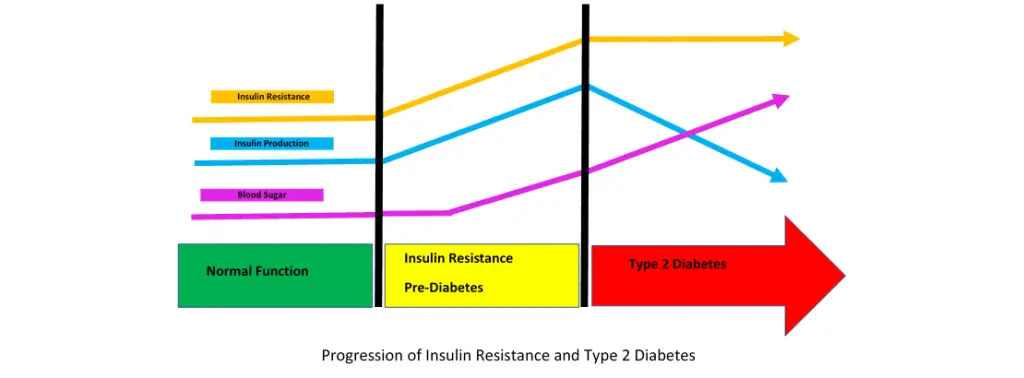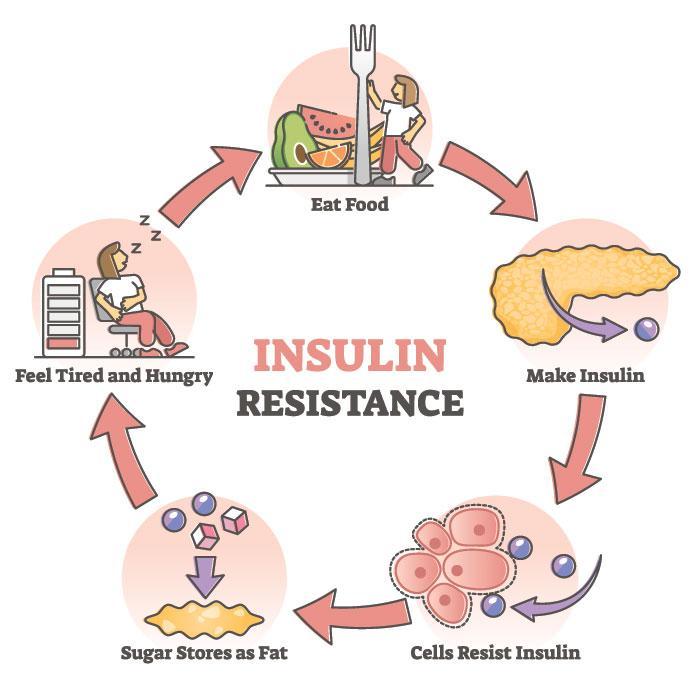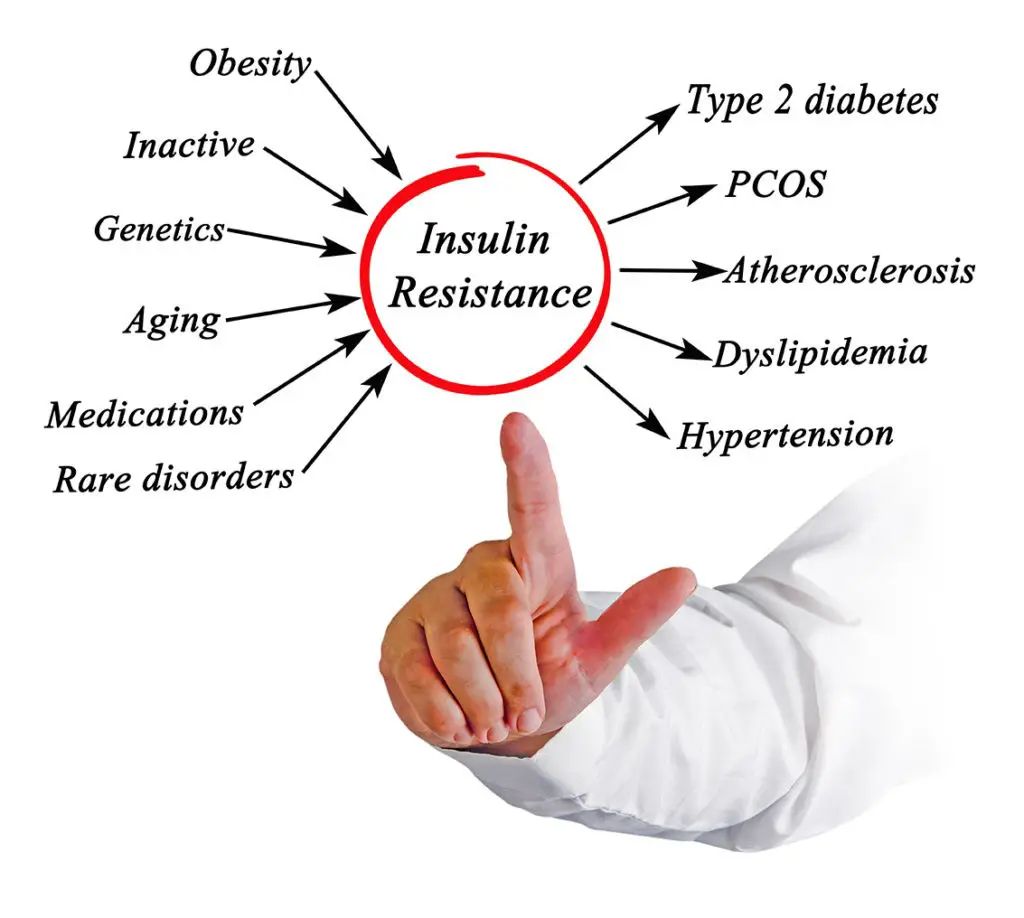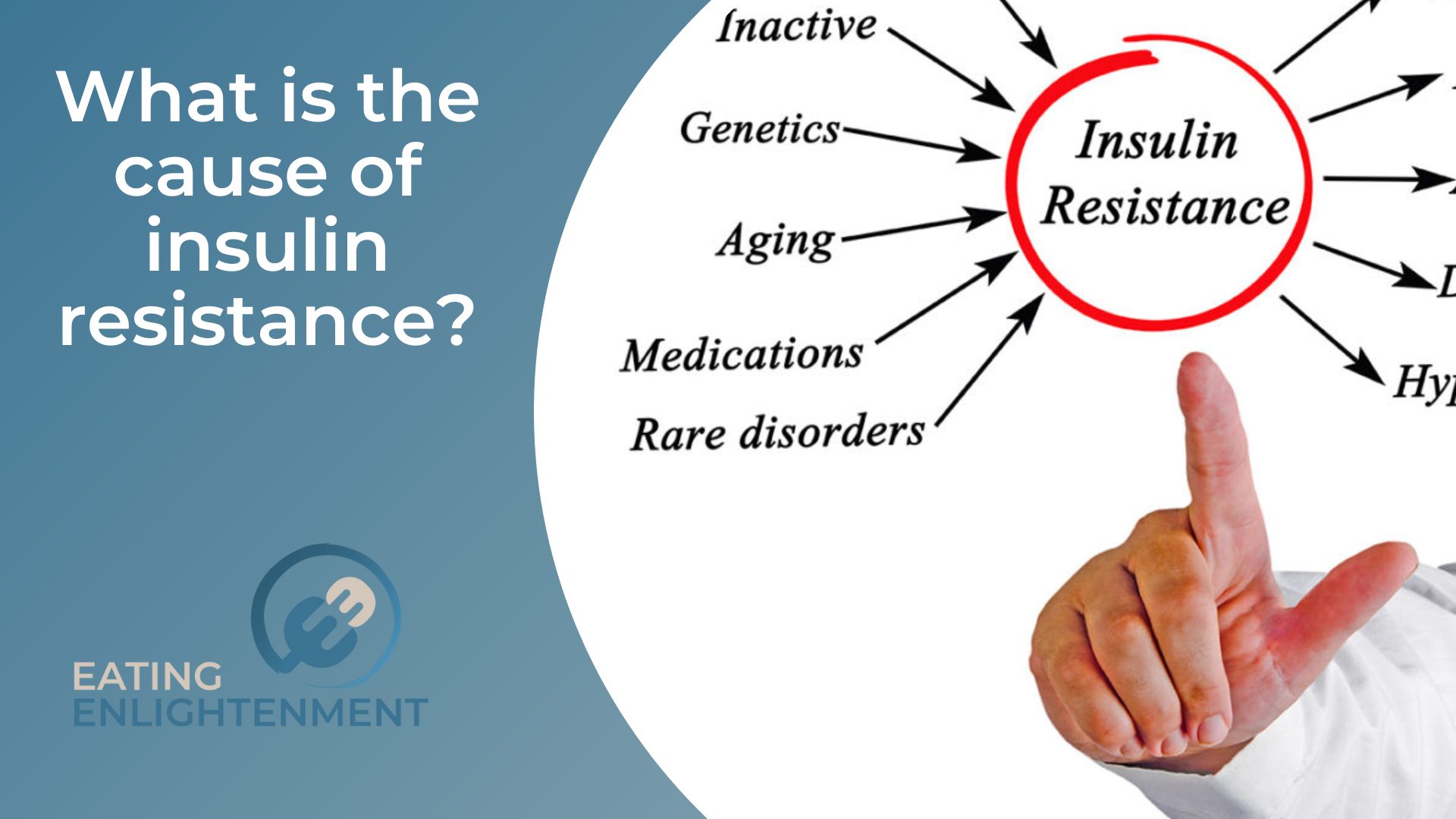Insulin resistance is a condition where the body does not use insulin properly.
This can lead to high blood sugar levels and various health problems.
What causes insulin resistance, and what can you do about it?
In this blog post, we will explore these questions in depth.
We will look at the different causes of insulin resistance, as well as some treatment options, including supplements for insulin resistance, that are available.
The difference between insulin resistance and prediabetes?

Insulin resistance is a condition where the body does not use insulin properly, leading to high blood sugar levels.
Prediabetes is a condition where your blood sugar levels are higher than normal but not yet high enough to be diagnosed as diabetes.
Insulin resistance can lead to prediabetes and eventually type 2 diabetes if it is left untreated.
However, making lifestyle changes such as eating a healthy diet, exercising regularly, and maintaining a healthy weight can help reduce insulin resistance and prevent or reverse prediabetes.
Medication may also be prescribed by your doctor if necessary.
Treatments like acupuncture, massage therapy, yoga or hypnosis may be recommended in order to help manage the symptoms of insulin resistance or prediabetes.
It is important to speak with your primary care physician if you have any questions or concerns about insulin resistance or prediabetes.
They can provide additional information and help you make the lifestyle changes necessary to reduce your risk of developing type 2 diabetes.
How do doctors diagnose insulin resistance and prediabetes?

The most common way to diagnose insulin resistance is through a fasting blood glucose test.
This test measures the amount of glucose in your bloodstream after you have gone at least 8 hours without eating or drinking anything.
If your levels are higher than normal, it could indicate that your body is not using insulin properly—a sign of insulin resistance.
Your doctor may also order other tests, such as an oral glucose tolerance test or a hemoglobin A1C test, to confirm the diagnosis.
How can I prevent or reverse insulin resistance and prediabetes?
If you have been diagnosed with insulin resistance, there are some steps that you can take to prevent or reverse the condition.
The main goal is to improve your overall health and reduce your risk of developing type 2 diabetes.
Making lifestyle changes such as eating a healthy diet, exercising regularly, and maintaining a healthy weight can help reduce insulin resistance.
Your doctor will likely recommend medications if needed. These may include metformin, sulfonylureas, thiazolidinediones (TZDs), dipeptidyl peptidase-4 (DPP-4) inhibitors, sodium-glucose cotransporter 2 (SGLT2) inhibitors, or GLP-1 receptor agonists.
In addition to lifestyle changes and medications, your doctor may also recommend other treatments such as acupuncture, massage therapy, yoga, or hypnosis.
By making the necessary lifestyle changes and following your doctor’s recommendations for treatment, you can help reduce your risk of developing type 2 diabetes and improve your overall health.
We hope that this blog post has provided you with a better understanding of what causes insulin resistance and how it can be prevented or reversed.
If you have any additional questions about insulin resistance or prediabetes, please talk to your primary care physician for further information
Who is more likely to develop insulin resistance or prediabetes?
Insulin resistance and prediabetes can affect anyone, but certain risk factors increase the likelihood of developing these conditions.
Factors that increase the risk include being overweight or obese, having a family history of type 2 diabetes, leading an inactive lifestyle, and having high blood pressure or high cholesterol levels.
Some ethnic and racial groups are more likely to develop insulin resistance or prediabetes than others—African Americans, Hispanics/Latinos, American Indians, Pacific Islanders, and Asian Americans are at higher risk for developing both conditions.
If you have any of these risk factors it is important to speak with your primary care physician about monitoring your health closely in order to prevent or reverse insulin resistance or prediabetes if necessary.
How Insulin Resistance Progresses to Type 2 Diabetes?

Insulin resistance is a condition where the body does not respond to insulin properly, leading to elevated levels of glucose in the blood. Over time, this can lead to type 2 diabetes if left untreated.
When the body’s cells don’t respond to insulin, they become resistant and require more insulin in order for glucose to be absorbed into the cells.
This causes an increase in blood sugar levels, which can damage organs and tissues and cause various health problems.
As insulin resistance progresses over time, it can lead to beta cell dysfunction which occurs when the pancreas is unable to produce enough insulin to keep up with the body’s needs.
Eventually, this leads to a diagnosis of type 2 diabetes as the body’s cells become increasingly resistant and cannot absorb glucose from the bloodstream anymore.
Symptoms of Insulin Resistance

Symptoms of insulin resistance can vary from person to person and some people may not experience any symptoms at all.
Common signs and symptoms include: fatigue, increased thirst, frequent urination, increased hunger, slow wound healing, and blurry vision.
Other signs and symptoms that may be associated with insulin resistance include:
- Weight gain/difficulty losing weight – Insulin resistance can lead to increased production of fat cells which can cause weight gain in certain areas such as the abdomen. It can also cause difficulty losing weight despite diet and exercise.
- Skin conditions – Acanthosis nigricans is a dark patchy discoloration that often appears around the neck or other body parts in those with insulin resistance. Additionally, those with insulin resistance may be more prone to skin infections or skin tags due to the high levels of sugar in their blood.
- Hair loss – Insulin resistance has been linked to hair loss due to its effects on hormones within the body which can affect hair growth.
- High blood pressure – Those with insulin resistance often have higher than normal blood pressure levels due to their bodies attempting to compensate for the lack of response from their cells in regards to insulin.
- Numbness or tingling sensations – Numbness or tingling sensations in hands, feet or other areas could be an indication of nerve damage caused by high levels of glucose in the blood over time.
- Sleep disruptions – Insulin resistance can also lead to sleep disturbances such as insomnia or excessive sleepiness due to hormonal changes as well as fluctuations in glucose levels throughout the day.
- Mood changes – Elevated glucose levels over an extended period of time can also affect moods and cause irritability or depression.
It is important to keep an eye out for any of these signs and symptoms as they could indicate a need for lifestyle changes or medical treatment if insulin resistance is present.
It is also important to speak with your doctor if you have any questions or concerns about potential risks or treatments for insulin resistance.
What is prediabetes?
Prediabetes is a condition where individuals have blood sugar levels that are higher than normal, but not high enough to be considered diabetic.
It usually occurs when the pancreas cannot produce enough insulin or when the body’s cells become increasingly resistant to it. Those with prediabetes typically have an increased risk of developing type 2 diabetes, heart disease, and stroke.
Prediabetes is becoming more common due to increasing rates of obesity, physical inactivity, and processed foods consumption; all of which can contribute to insulin resistance.
Research has also shown that certain ethnicities may be more prone to prediabetes such as Hispanic/Latino Americans and Native Americans.
Diagnosing prediabetes can be done through a fasting plasma glucose test or an oral glucose tolerance test.
What causes insulin resistance and prediabetes?

Insulin resistance and prediabetes are caused by a number of factors, many of which are lifestyle-related.
These can include being overweight or obese, leading a sedentary lifestyle, having an unhealthy diet, consuming high amounts of processed foods and added sugars, smoking, drinking excessive amounts of alcohol, and genetics.
Being overweight or obese is one of the major causes of insulin resistance and prediabetes because it increases the amount of fat cells in the body.
This leads to increased production of hormones that interfere with how insulin works in the body, causing it to become less effective in regulating blood sugar levels.
And also being overweight or obese can cause inflammation within the body which is linked to insulin resistance as well.
A sedentary lifestyle can also affect how well your body responds to insulin due to decreased muscle mass.
Muscles cells require more glucose than other cells in order to function properly so when there is less muscle mass due to lack of physical activity this affects how glucose is dispersed throughout the body and leads to things such as high blood sugar levels.
Having an unhealthy diet can also increase risk for developing insulin resistance and prediabetes.
Those who consume large amounts of highly processed foods have increased risk for weight gain which can lead to the aforementioned issues associated with it.
Eating too much added sugars such as those found in sodas and sweets can also increase risk for insulin resistance due to their effects on raising blood sugar levels and increasing fat storage in the body.
Smoking has been linked to numerous health risks including diabetes due its effect on increasing inflammation within the body as well as its contribution to weight gain from nicotine cravings.
Drinking excessive amounts of alcohol has also been found to increase risk for prediabetes due to its ability to raise blood sugar levels even if consumed in moderation over time.
Genetics may also play a role depending on family history; some people may be genetically predisposed towards developing certain conditions such as diabetes.
It is important therefore that individuals take steps towards controlling these factors by maintaining a healthy weight through diet and exercise, eating balanced meals with minimal processing involved, avoiding smoking and limiting alcohol consumption, and speaking with their doctor about any family history they may have regarding diabetes or other metabolic diseases.
By doing these things individuals will be able lower their risk for developing insulin resistance and prediabetes which can then help prevent further health issues from arising down the line.
How can I reduce insulin resistance?
One of the most effective ways to reduce insulin resistance is through diet and physical activity.
Making sure to eat a balanced diet with plenty of fruits, vegetables, whole grains, and lean proteins can help to regulate blood sugar levels and improve body weight.
Additionally, it is important to limit processed foods, added sugars, and refined carbohydrates as these can contribute to further insulin resistance.
Regular physical activity has also been found to be beneficial in addressing insulin resistance due to its ability to increase muscle mass which helps with glucose uptake from the bloodstream.
Aiming for at least 30 minutes of exercise per day such as walking, jogging, cycling or swimming can help improve insulin sensitivity in those who are physically inactive or overweight.
In addition to diet and physical activity other lifestyle changes can also be made in order to reduce risk for prediabetes or reverse existing insulin resistance.
These include quitting smoking if you’re a smoker as well as limiting alcohol consumption since both of these activities have been linked with increased risk for prediabetes.
It is also important that individuals get adequate sleep as inadequate amounts of sleep can cause hormone imbalances which affect how efficiently the body responds to insulin.
Supplements may also be beneficial in reducing insulin resistance depending on individual needs; some supplements such as omega-3 fatty acids and chromium have been shown to help improve symptoms associated with diabetes including improving blood sugar control and reducing inflammation within the body.
It is however important that individuals seek advice from their doctor before taking any supplement as they may interact with other medications or pose health risks not associated with otherwise healthy individuals.
Making sure that you have regular check-ups with your doctor is also essential when it comes to diagnosing prediabetes or addressing existing cases of insulin resistance.
Your doctor will be able to monitor your progress over time through routine tests such as checking your fasting plasma glucose levels or doing an oral glucose tolerance test if necessary.
Knowing this information will help you make informed decisions about whether or not dietary changes or lifestyle modifications need to be made in order for you manage conditions associated with diabetes better going forward.
Summary
Insulin resistance is a condition that affects many people in the United States and can lead to prediabetes or type 2 diabetes if left unchecked.
While genetics may play a role, it is largely caused by lifestyle factors such as diet and physical activity. In order to reduce insulin resistance it is important for individuals to maintain a healthy weight through balanced meals with minimal processing involved as well as exercising regularly.
And quitting smoking and limiting alcohol consumption has also been shown to be beneficial for reducing one’s risk for developing insulin resistance.
Supplements may also help depending on individual needs however speak with your doctor beforehand before taking any supplement.
And yes making sure you have regular check-ups with your doctor will help you monitor progress over time and make informed decisions about how to better manage insulin resistance going forward.



